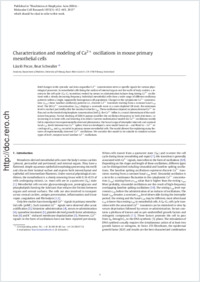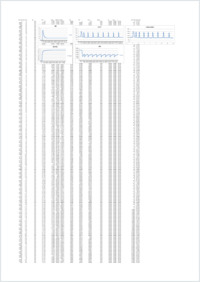Characterization and modeling of Ca2 + oscillations in mouse primary mesothelial cells
- Pecze, László Anatomy, Department of Medicine, University of Fribourg, Switzerland
- Schwaller, Beat Anatomy, Department of Medicine, University of Fribourg, Switzerland
-
01.03.2015
Published in:
- Biochimica et Biophysica Acta (BBA) - Molecular Cell Research. - 2015, vol. 1853, no. 3, p. 632–645
English
Brief changes in the cytosolic and intra-organellar Ca2 + concentration serve as specific signals for various physiological processes. In mesothelial cells lining the surface of internal organs and the walls of body cavities, a re-entry in the cell cycle (G₀–G₁ transition) evoked by serum re-administration induces long-lasting Ca2 + oscillations with a slowly decreasing frequency. Individual mesothelial cells show a wide range of different oscillatory patterns within a single, supposedly homogenous cell population. Changes in the cytoplasmic Ca2 + concentration (ccyt) show baseline oscillatory patterns i.e., discrete Ca2 + transients starting from a constant basal ccyt level. The ER Ca2 + concentration (cER) displays a sawtooth wave at a semi-depleted ER state; the minimum level is reached just briefly after the maximal value for ccyt. These oscillations depend on plasmalemmal Ca2 + influx and on the inositol trisphosphate concentration [InsP₃]; the Ca2 + influx is a crucial determinant of the oscillation frequency. Partial blocking of SERCA pumps modifies the oscillation frequency in both directions, i.e. increasing it in some cells and lowering it in others. Current mathematical models for Ca2 + oscillations mostly fail to reproduce two experimentally observed phenomena: the broad range of interspike intervals and constant basal ccyt levels between two Ca2 + spikes. Here we developed a new model based on – and fitted to – Ca2 + recordings of ccyt and cER recorded in primary mouse mesothelial cells. The model allowed for explaining many features of experimentally observed Ca2 + oscillations. We consider this model to be suitable to simulate various types of InsP₃ receptor-based baseline Ca2 + oscillations.
- Faculty
- Faculté des sciences et de médecine
- Department
- Département de Médecine
- Language
-
- English
- Classification
- Biological sciences
- License
- License undefined
- Identifiers
-
- RERO DOC 255667
- DOI 10.1016/j.bbamcr.2014.12.025
- Persistent URL
- https://folia.unifr.ch/unifr/documents/304258
Other files
Statistics
Document views: 47
File downloads:
- sch_cmc.pdf: 138
- sch_cmc_sm.pdf: 71

